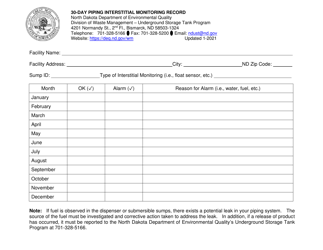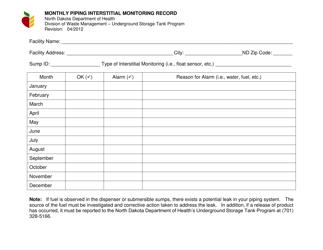30-day Interstitial Monitoring Log for Double-Walled Tanks - North Dakota
30-day Interstitial Monitoring Log for Double-Walled Tanks is a legal document that was released by the North Dakota Department of Environmental Quality - a government authority operating within North Dakota.
FAQ
Q: What is a 30-day interstitial monitoring log?
A: A 30-day interstitial monitoring log is a record used to track and document the monitoring of the interstitial space of a double-walled tank.
Q: What is the purpose of a double-walled tank?
A: The purpose of a double-walled tank is to provide an extra layer of protection to prevent leaks or spills.
Q: What is the interstitial space of a double-walled tank?
A: The interstitial space is the space between the inner and outer walls of a double-walled tank.
Q: Why is monitoring the interstitial space important?
A: Monitoring the interstitial space is important to detect any leaks or spills that may occur within the double-walled tank.
Q: How often should the interstitial space of a double-walled tank be monitored?
A: The interstitial space of a double-walled tank should be monitored at least once every 30 days.
Q: Who is responsible for monitoring the interstitial space?
A: The owner or operator of the double-walled tank is responsible for monitoring the interstitial space.
Q: What information should be recorded in the 30-day interstitial monitoring log?
A: The 30-day interstitial monitoring log should include the date of monitoring, the name of the person performing the monitoring, and the results of the monitoring.
Q: What should be done if a leak or spill is detected during monitoring?
A: If a leak or spill is detected during monitoring, immediate action should be taken to address the issue and prevent further damage or contamination.
Q: Are there any regulations or requirements for monitoring the interstitial space of double-walled tanks in North Dakota?
A: Yes, there are regulations and requirements for monitoring the interstitial space of double-walled tanks in North Dakota. These requirements may vary, so it is important to consult the applicable regulations or contact the appropriate regulatory authority for specific information.
Form Details:
- Released on January 1, 2021;
- The latest edition currently provided by the North Dakota Department of Environmental Quality;
- Ready to use and print;
- Easy to customize;
- Compatible with most PDF-viewing applications;
- Fill out the form in our online filing application.
Download a printable version of the form by clicking the link below or browse more documents and templates provided by the North Dakota Department of Environmental Quality.




